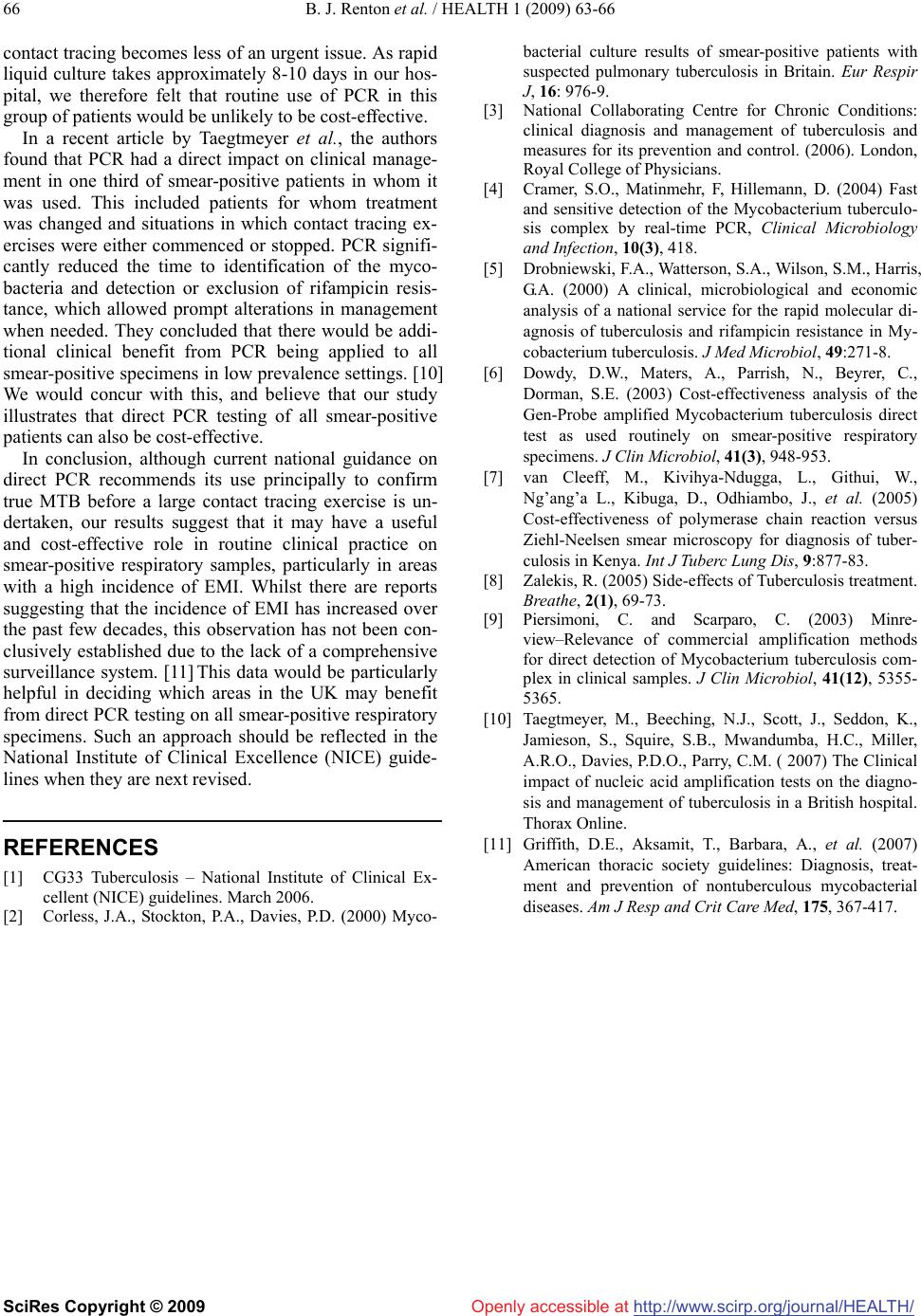
B. J. Renton et al. / HEALTH 1 (2009) 63-66
http://www.scirp.org/journal/HEALTH/
66
Openly accessible at
contact tracing becomes less of an urgent issue. As rapid
liquid culture takes approximately 8-10 days in our hos-
pital, we therefore felt that routine use of PCR in this
group of patients would be unlikely to be cost-effective.
In a recent article by Taegtmeyer et al., the authors
found that PCR had a direct impact on clinical manage-
ment in one third of smear-positive patients in whom it
was used. This included patients for whom treatment
was changed and situations in which contact tracing ex-
ercises were either commenced or stopped. PCR signifi-
cantly reduced the time to identification of the myco-
bacteria and detection or exclusion of rifampicin resis-
tance, which allowed prompt alterations in management
when needed. They concluded that there would be addi-
tional clinical benefit from PCR being applied to all
smear-positive specimens in low prevalence settings. [10]
We would concur with this, and believe that our study
illustrates that direct PCR testing of all smear-positive
patients can also be cost-effective.
In conclusion, although current national guidance on
direct PCR recommends its use principally to confirm
true MTB before a large contact tracing exercise is un-
dertaken, our results suggest that it may have a useful
and cost-effective role in routine clinical practice on
smear-positive respiratory samples, particularly in areas
with a high incidence of EMI. Whilst there are reports
suggesting that the incidence of EMI has increased over
the past few decades, this observation has not been con-
clusively established due to the lack of a comprehensive
surveillance system. [11] This data would be particularly
helpful in deciding which areas in the UK may benefit
from direct PCR testing on all smear-positive respiratory
specimens. Such an approach should be reflected in the
National Institute of Clinical Excellence (NICE) guide-
lines when they are next revised.
REFERENCES
[1] CG33 Tuberculosis – National Institute of Clinical Ex-
cellent (NICE) guidelines. March 2006.
[2] Corless, J.A., Stockton, P.A., Davies, P.D. (2000) Myco-
bacterial culture results of smear-positive patients with
suspected pulmonary tuberculosis in Britain. Eur Respir
J, 16: 976-9.
[3] National Collaborating Centre for Chronic Conditions:
clinical diagnosis and management of tuberculosis and
measures for its prevention and control. (2006). London,
Royal College of Physicians.
[4] Cramer, S.O., Matinmehr, F, Hillemann, D. (2004) Fast
and sensitive detection of the Mycobacterium tuberculo-
sis complex by real-time PCR, Clinical Microbiology
and Infection, 10(3), 418.
[5] Drobniewski, F.A., Watterson, S.A., Wilson, S.M., Harris,
G.A. (2000) A clinical, microbiological and economic
analysis of a national service for the rapid molecular di-
agnosis of tuberculosis and rifampicin resistance in My-
cobacterium tuberculosis. J Med Microbiol, 49:271-8.
[6] Dowdy, D.W., Maters, A., Parrish, N., Beyrer, C.,
Dorman, S.E. (2003) Cost-effectiveness analysis of the
Gen-Probe amplified Mycobacterium tuberculosis direct
test as used routinely on smear-positive respiratory
specimens. J Clin Microbiol, 41(3), 948-953.
[7] van Cleeff, M., Kivihya-Ndugga, L., Githui, W.,
Ng’ang’a L., Kibuga, D., Odhiambo, J., et al. (2005)
Cost-effectiveness of polymerase chain reaction versus
Ziehl-Neelsen smear microscopy for diagnosis of tuber-
culosis in Kenya. Int J Tuberc Lung Dis, 9:877-83.
[8] Zalekis, R. (2005) Side-effects of Tuberculosis treatment.
Breathe, 2(1), 69-73.
[9] Piersimoni, C. and Scarparo, C. (2003) Minre-
view–Relevance of commercial amplification methods
for direct detection of Mycobacterium tuberculosis com-
plex in clinical samples. J Clin Microbiol, 41(12), 5355-
5365.
[10] Taegtmeyer, M., Beeching, N.J., Scott, J., Seddon, K.,
Jamieson, S., Squire, S.B., Mwandumba, H.C., Miller,
A.R.O., Davies, P.D.O., Parry, C.M. ( 2007) The Clinical
impact of nucleic acid amplification tests on the diagno-
sis and management of tuberculosis in a British hospital.
Thorax Online.
[11] Griffith, D.E., Aksamit, T., Barbara, A., et al. (2007)
American thoracic society guidelines: Diagnosis, treat-
ment and prevention of nontuberculous mycobacterial
diseases. Am J Resp and Crit Care Med, 175, 367-417.
SciRes Copyright © 2009